The Good, The Bad and The Ugly….
Each time I go on a landscape consult, it is an adventure. I never know what to expect. Will there be serious problems with any of the trees and plants? Or will my help be needed to re-design the landscape, adjust the irrigation schedule or help people learn how to maintain their plants? Well, life is full of surprises.
Of course, every time I go on a consult, I always bring my camera. I am always looking for examples of beautiful plants and problems to photograph. I then share many of them with you.
Yesterday, was a gorgeous spring day. The high was 78 degrees and I actually had two consults scheduled, within two miles of each other. My first client had just bought a new home and wanted help identifying her plants and how to take care of them. She also had inherited some sick citrus trees and needed help in how to help them.
First the good things that I saw….
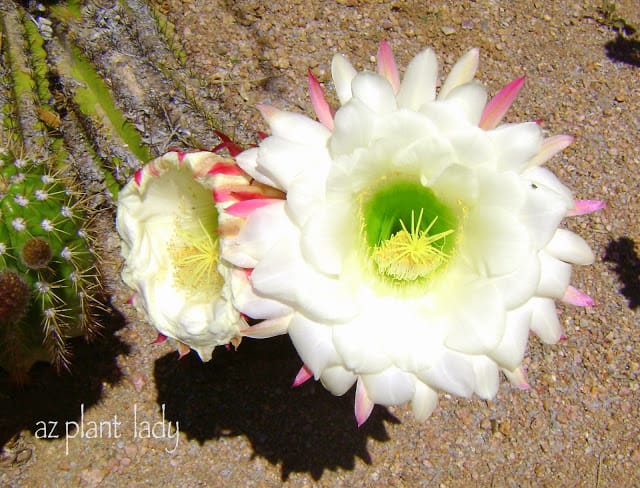
I was greeted by the front entry by this spectacular white flower. Argentine Giant (Trichocereus candicans), is a cactus that is highly desired. It produces flowers a few times during spring and summer months. This particular cactus was absolutely covered in these large blossoms.
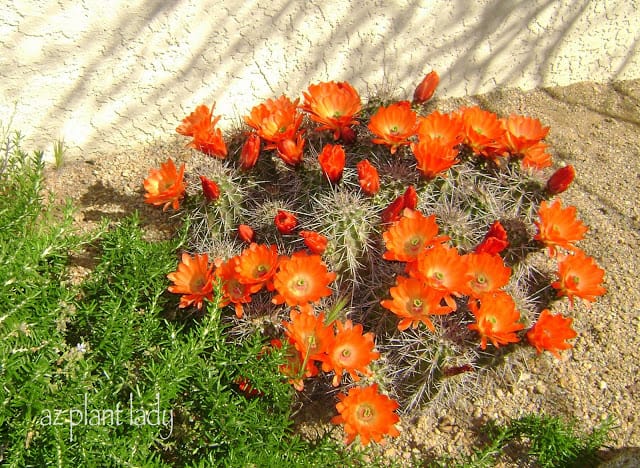
Nearby the Argentine Giant, was the smaller Claret Cup Cactus (Echinocereus triglochidiatus) awash in bright orange blooms.
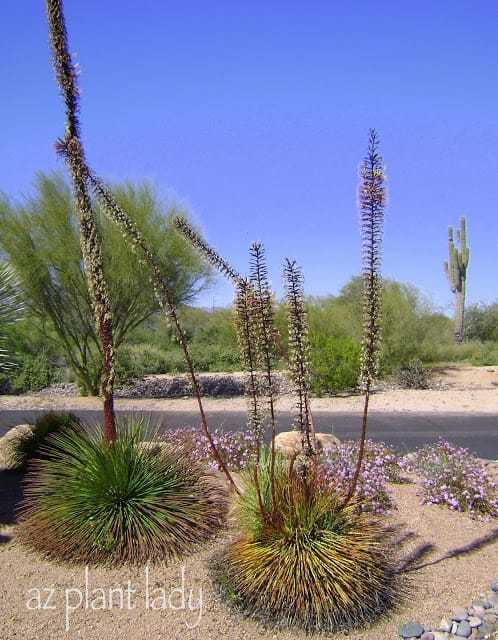
An unusually shaped flowering Twin Flower Agave (Agave geminiflora) caught my eye. Normally, they produce a single flowering stalk like the one on the left. However, the one on the right had seven smaller stalks. I love seeing examples of plants that are doing something out of the ordinary 🙂
Now for the bad….
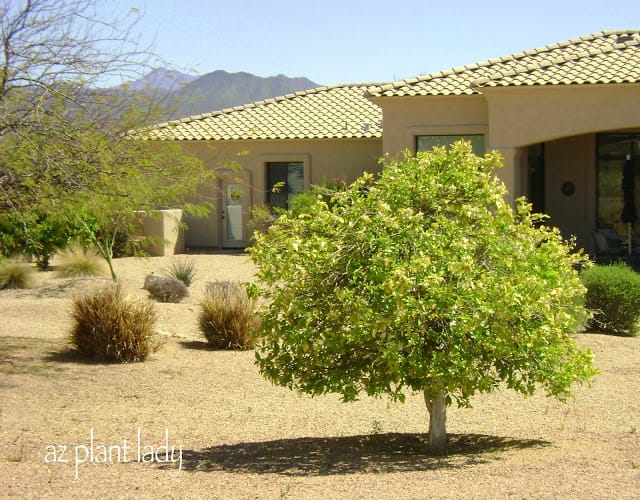
This is one of the four sickly citrus trees that I was asked to see. The diagnosis was relatively easy. Lack of water and nutrient deficiency. Both problems will be solved by enlarging the basin underneath the tree so that it extends out to where the branches end. As the tree grows, so must the basin since a trees roots extend outwards where the branches extend. A new watering schedule and making sure that the water penetrates to 3 ft. in depth should do much to help these trees.
Nutrient deficiencies are corrected by fertilizing citrus trees three times a year – in Feb/Mar, May and September, using either a synthetic or organic fertilizer specially formulated for citrus which contains not only nitrogen, but also micronutrients that are often deficient in our soils.
More information on citrus care, irrigation and fertilization can be found here.
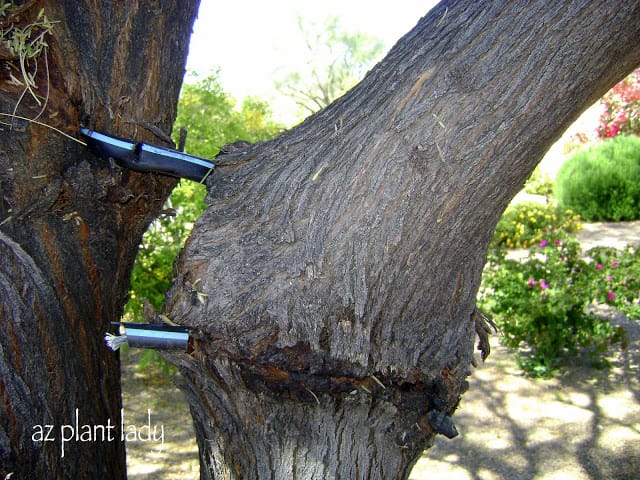
As I walked the landscape with the homeowner, we started looking at the trees that she had inherited with her new home. I quickly noticed something very bad. The previous homeowners had never removed the stake and cables from their tree when it was young.
The tree ended up growing around the wire and there is no way to remove it now without seriously damaging the tree. Usually, when wires are left on the tree, they gradually cut off the nutrients to the tree as the “veins” of the tree are located directly underneath the bark. This usually results in the death of the tree. However, this Mesquite tree appears to have survived and regrown it’s vascular (veins) system around the wire. The tree is 11 years old and is the exception in terms of surviving this type of treatment.
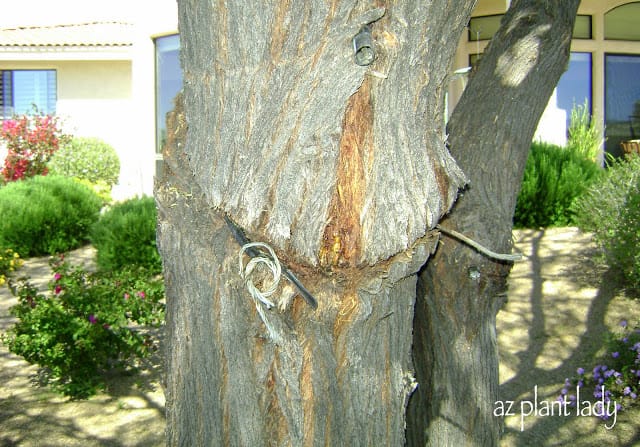
**If your trees are staked, PLEASE make sure to check your wires/cables to make sure that this does not happen to you. Trees are not to be staked forever, only the first 1 – 2 years after planting.
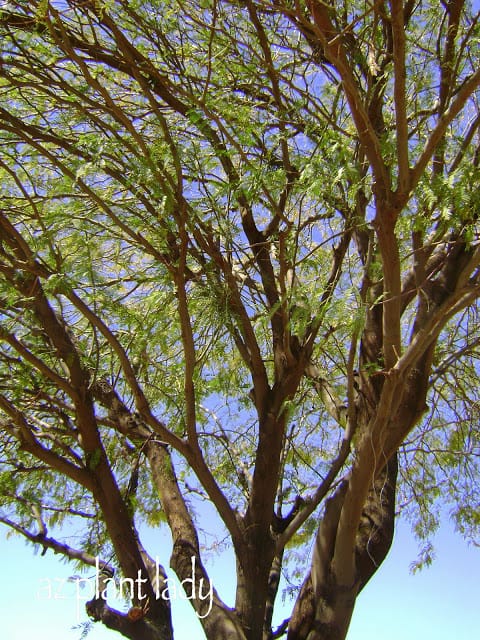
Now the next bad thing I observed was not immediately obvious, but as I began to focus my gaze upwards to evaluate the trees, I saw a few clumps of mistletoe (Phoradendron californicum) growing in the tree. Now, this is not the same kind of leafy mistletoe that is often seen at Christmas. But it is a parasite that will, over time, cause a decline in the tree and stress the tree. This makes the tree more susceptible to disease, insect infestations and other stresses.
As an arborist, I have taken part in discussions regarding whether or not you should leave mistletoe in trees. Mistletoe is part of the natural desert and can be seen growing in trees in the wild. Mistletoe itself will not kill a tree, but does stress the tree and leaves it vulnerable to disease, insects and environmental stresses that will kill the tree eventually.
In managed landscape areas I have always had mistletoe removed. In my opinion, trees do not need any additional stress and the trees are part of a larger landscape design and aesthetics are important.
I also recommend that homeowners also remove the mistletoe from their trees. Not only will it help their tree, but will help keep the mistletoe from spreading to their neighbor’s trees. Mistletoe is spread when birds eat the berries it produces and then they ‘poop’ them out on another tree’s branch and the seed germinates and starts to infect the branch it landed on.
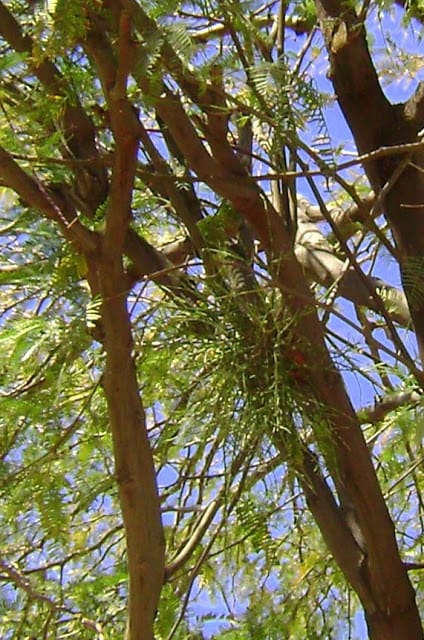
Small clumps of mistletoe are not always obvious, but once you know what to look for, you will easily be able to spot it. I recommend looking at your tree in the winter, when there are fewer leaves to hide the mistletoe.
There are two ways to remove mistletoe. To completely get rid of it, you need to cut the branch that it occurs on at least 12″ below where the mistletoe begins. In most cases, this will completely get rid of the mistletoe. This works best with smaller branches. However, if you have a very large branch that is infected, it may not be feasible to remove the branch. In this case, you can prune the mistletoe off – just take your gloved hand and brush them off of the branch. It is really that easy. Doing this will not get rid of the mistletoe, but help to control it. You will have to continue to do this periodically to keep the mistletoe from becoming larger and spreading.
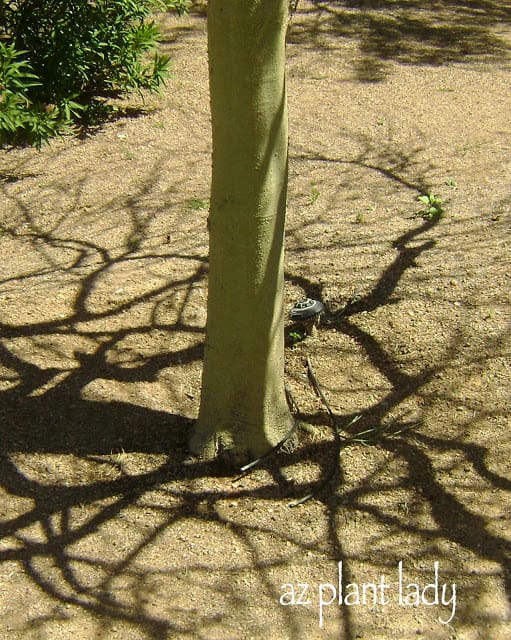
Now on to my second client of the day. Overall, is landscape was in good shape. His citrus trees were healthy as were the rest of his plants. But, the majority of his concerns were in regards to his irrigation system. His mature Palo Brea tree (Parkinsonia praecox), pictured above, still had the irrigation emitters positioned by the trunk of the tree. The same place that they had been place 8 years ago. The problem is, the roots have now moved.
I explained to him that as a tree grows, so do the roots. They grow outwards, toward the edge of where the branches extend. And so as the tree grows, the emitters need to be moved and places around the tree where the branches end. For this tree, three 2 (gph) emitters evenly spaced around the tree will work just fine.
Well, I had a very fulfilling day working with some very nice people. I just love help people learn how to care for their trees and plants and spend time outdoors and admiring the beauty in people’s gardens.
As I was leaving, I saw something very ugly….

This homeowner had ‘topped’ his Mesquite tree. Now, I am not sure why they had this done. I could tell that from looking at the branches, that it was not the first time it had been ‘topped’.
Now any arborist will tell you that ‘topping’ is bad and there are a number of reasons why. I will address it further in another post, but will leave you with these few reasons NOT to top your trees:
-It causes the tree to grow more quickly to replace the leaves lost, therefore increasing the amount of pruning needed.
-The new branches will not be firmly attached and will be more likely to break.
-Topping stresses the tree, making it susceptible to disease, insects and environmental stresses.
-If those reasons are not enough, then maybe this one will be….IT IS UGLY.
*For more information on the damage ‘topping’ trees does, you can visit The International Society of Arboriculture.
Thank you for hanging in there with me…I realize this was a long post, but there was so much to ‘talk’ about from my visits yesterday. I hope you enjoyed the beauty of the flowers and that maybe I have helped people avoid some of the problems that I have highlighted.
“Scary” Pruning Practices and the Unfortunate Results

 Noelle Johnson, aka, 'AZ Plant Lady' is a author, horticulturist, and landscape consultant who helps people learn how to create, grow, and maintain beautiful desert gardens that thrive in a hot, dry climate. She does this through her consulting services, her online class Desert Gardening 101, and her monthly membership club, Through the Garden Gate. As she likes to tell desert-dwellers, "Gardening in the desert isn't hard, but it is different."
Noelle Johnson, aka, 'AZ Plant Lady' is a author, horticulturist, and landscape consultant who helps people learn how to create, grow, and maintain beautiful desert gardens that thrive in a hot, dry climate. She does this through her consulting services, her online class Desert Gardening 101, and her monthly membership club, Through the Garden Gate. As she likes to tell desert-dwellers, "Gardening in the desert isn't hard, but it is different."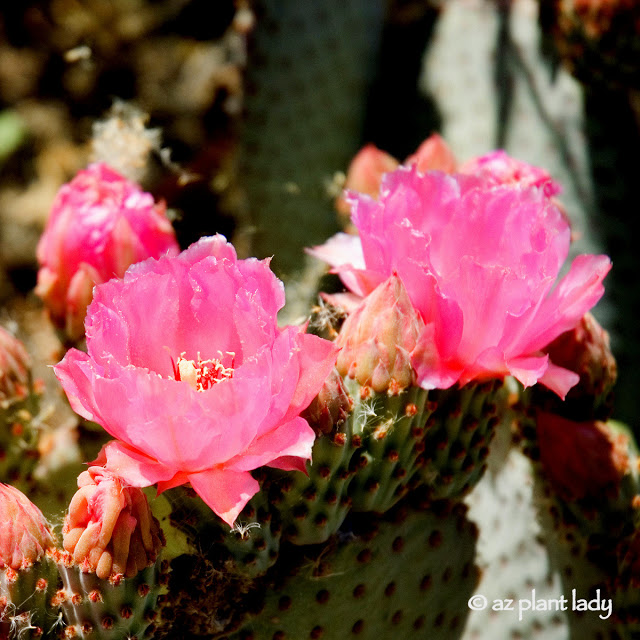
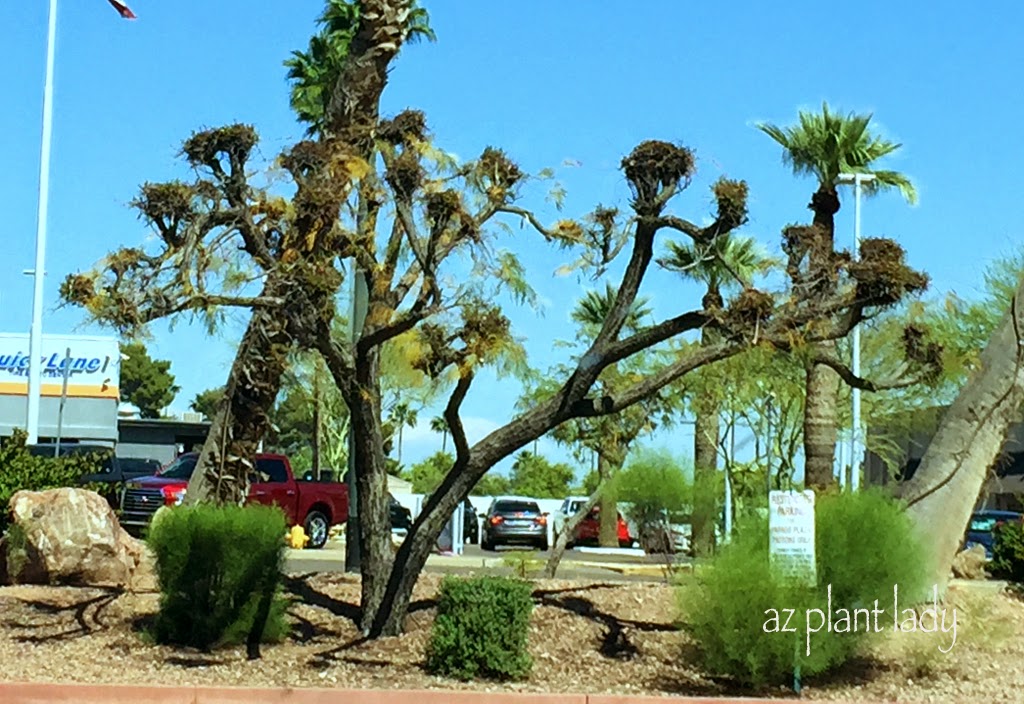
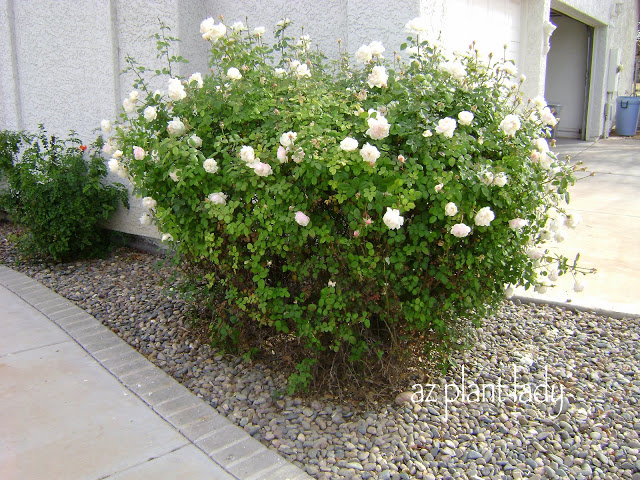
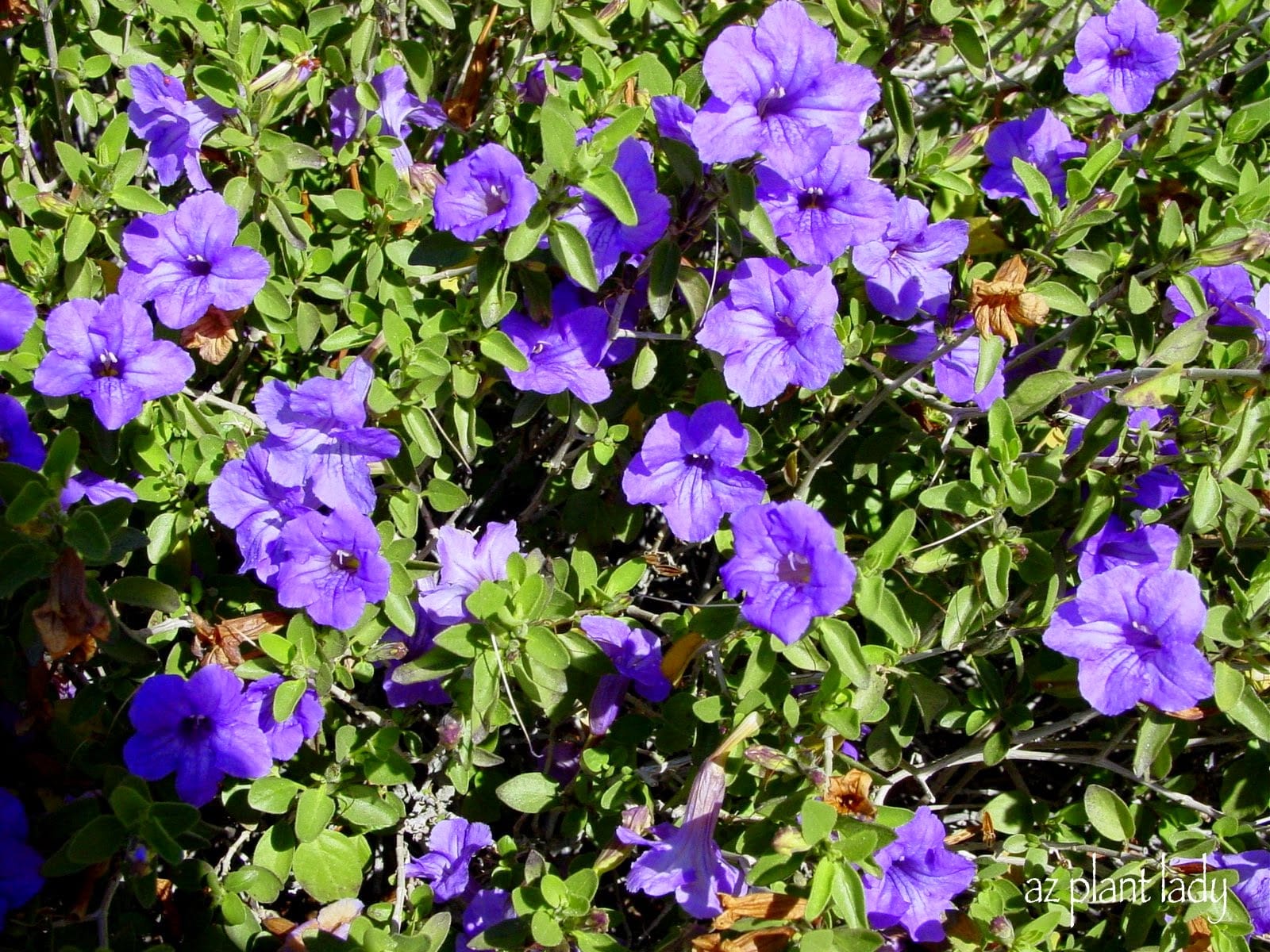
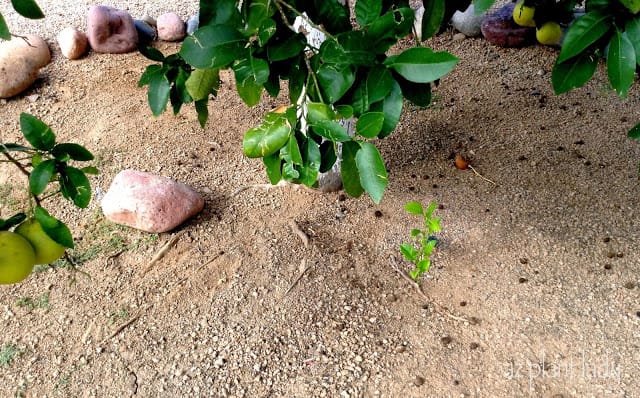







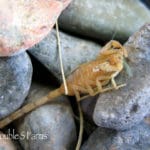

Very interesting post Noelle, the white cactus flowers are stunning. I found the pictures of the cable grown into the tree absolutely grotesque and hard to look at. Poor tree. As for the topped Mesquite tree, will the cessation of pruning return the tree to a natural shape, or would something drastic have to be done at this point?
I've never seen a picture of an Agave geminiflora bloom before, thank you! And that poor poor tree with the wires…really who could be so clueless!
Dear Noelle, This is a most interesting and informative posting which is full of very sound advice. It is fascinating to learn something about your work and the kinds of problems you encounter when visiting clients.
That Agave is outsanding! Love it! The ugly is ugly, indeed. But what concerns me the most is how do not topple the trees/shrubs and keep their size under control. I read info, check the Internet, try to follow the tips, but it's still a challenge for me. Your posts are very helpful. Thanks, Noelle!
Very informational post as always, Noelle. Thanks for taking time to post your consulting experience and share with us! The first cactus flower is so beautiful! I love it!
Trees are such an important, and often costly, part of the garden. You'd think people would take more time to learn the right way to care for them.
The agave is very interesting. At first, I thought it was a sotol. Does this one die, after blooming, like the other agaves?
Thanks for sharing your experience with us.
~~Linda…
You have a great job! Working with plants and educating homeowners on a daily basis must be very rewarding. I was shocked to see the cables and stakes still in place on that tree. I find that some people are afraid to alter anything a professional has done.
It makes me sad to see the wounded mesquite trees, and it reminds me somehow of humans who have overcome incredibly limiting circumstances put in place by the carelessness of others. In a way, your homeowner might be proud to host such survivors in her yard, as a testament to spirit.
Oh, dear, I read too much into the plants; don't I? 😉
Love, love, love that orange-flowered cactus. So exotic and beautiful!
Noelle, This is a great post; I learned so much from it. I really feel bad for that topped tree. -Jean
Great post, Noelle, with lots of helpful information for local gardeners and beyond. What a sad sight that staked tree was.
Very neat post. The pics of the cactus are really cool. Now why anyone would give a tree a haircut is beyond me. jim
I don't understand why people top their trees and shrubs like that. Do they really think that's aesthetically pleasing? Really?? O_O
I hate topped trees and staking. I don't understand why staking seems to be a standard practice, when it really doesn't need to be done that often.
That Argentine Giant is a real beauty! What a shame to see that tree wounded by stakes!
Gawd! The tree does look Ugly after being 'TOPPED'. I am not even sure how it can be topped so symmetrically. Anyways… its enjoyed the Good part of the blog. Lovely shots n description!
I love the cacti (cactuses?), the flower on that first one is amazing. I wonder how no one noticed that cable had been left on the tree. I guess some people plant things and then never really think about them again.
This was a really interesting post, lots to learn from it.
oh that poor tree! but those cacti are fabulous especially the first one. Great post Noelle …. I'm late for work otherwise I would have written more.
Hi Noelle, what a bizarre coincidence – I just put up a post on Australian mistletoe! I'm a bit embarrassed that I hadn't popped in to read your blog before I posted now 🙁 Never mind – your information on how to deal with mistletoe in the home garden will be very useful for me if one pops up in my garden!
A very informative post, Noelle, but I'm still thinking about that Argentine Giant cactus–it is gorgeous! I love seeing all the cacti in bloom and the different species you show here.
Your information on topping trees is very timely, too–my last Master Gardeners class was about trees, and we were taught the very things you include here. And yet I've seen so many trees topped off over the years; it makes me wonder why these tree trimming companies continue to do this.
Hi Noelle,
Here in Sun Lakes I have noticed what seems to be a trend in topping desert trees. There are more and more of them. What a shame! I feel like knocking on people's doors and telling them the problems they are creating.
This post is so interesting and not too long at all!
Gorgeous cacti. I'm surprised the Mesquite tree survived having the stakes and wires left on. That's one tough tree.
Ouch on the topped tree. Even if it didn't really hurt the tree it screams "WRONG" in the context of a desert garden where plants usually get to be themselves with fairly minor shaping. It reminds me of pollarded European trees, not my favs.
And ouch too on the trees with the wires still embedded in them. You read that it's a bad thing, but I'm glad you've posted some photos so folks take better care of their trees!
I see the same things all the time. It's really sad.
That poor topped mesquite tree. It looks rather like my students when they get a bad haircut, but it can't put on a hat to cover the damage.